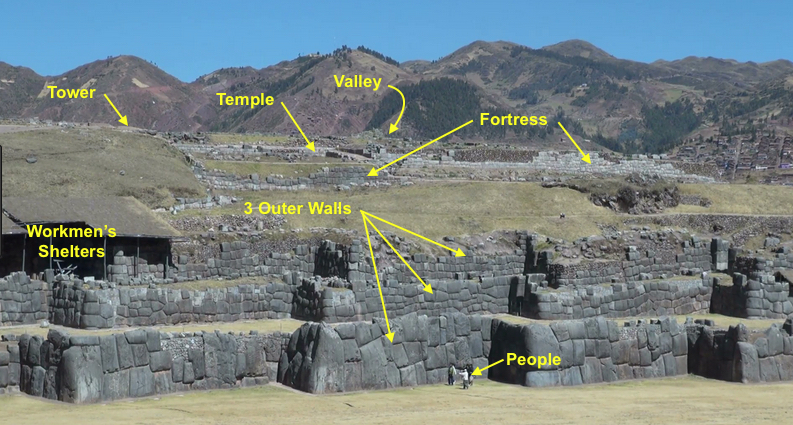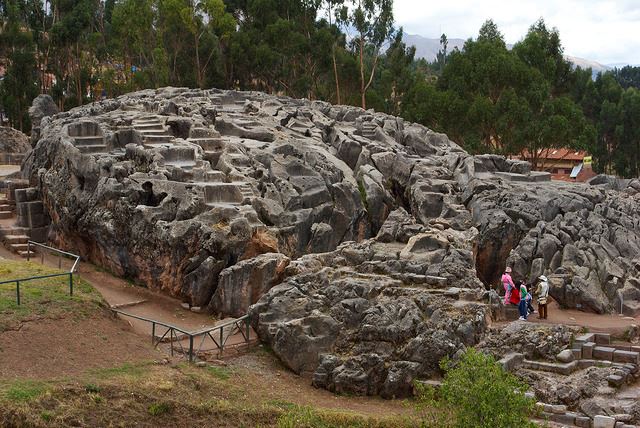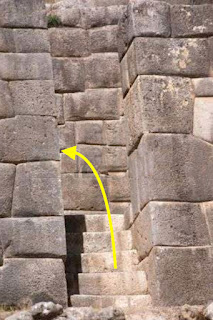|
|
Post by 1dave on Sept 2, 2018 7:05:42 GMT -5
|
|
|
|
Post by rockjunquie on Sept 2, 2018 10:00:46 GMT -5
Interesting stuff. Those "older" boulder cuts are amazing. The joints are just so perfect!
|
|
Deleted
Deleted Member
Member since January 1970
Posts: 0
|
Post by Deleted on Sept 2, 2018 11:12:32 GMT -5
I'll just say that the finer masonry at the bottom, with rougher at the top, is also observed in other cultures (Levantine, Egyptian, Roman, etc. and even modern). They tended to put the most effort on masonry courses that was exposed, and use rubble for areas that ended up in attics or under surfaces that were plastered over (ground level and orthostat stonework also was more durable than plaster (the reason that we still employ wood/stone/tile wainscoting, door casings, corner beads, baseboards and stair skirtboards to protect high-wear areas on the walls of our modern homes), in addition to being more decorative). Many of those Incan walls with finely fitted joints also look better from the front than the back (where the joints are much looser, and in many cases don't look much different than a stacked rubble wall). Like most builders, much more effort went into the "money side" than to areas which would front less important rooms, would be hidden in gables, beneath plaster or other decoration, etc. Just my alternative take on why the differences. Doesn't lessen my respect for the awesome skill of Incan builders (in basalt, no less).
|
|
|
|
Post by rockjunquie on Sept 2, 2018 11:26:12 GMT -5
I'll just say that the finer masonry at the bottom, with rougher at the top, is also observed in other cultures (Levantine, Egyptian, Roman, etc. and even modern). They tended to put the most effort on masonry courses that was exposed, and use rubble for areas that ended up in attics or under surfaces that were plastered over (ground level and orthostat stonework also was more durable than plaster (the reason that we still employ wood/stone/tile wainscoting, door casings, corner beads, baseboards and stair skirtboards to protect high-wear areas on the walls of our modern homes), in addition to being more decorative). Many of those Incan walls with finely fitted joints also look better from the front than the back (where the joints are much looser, and in many cases don't look much different than a stacked rubble wall). Like most builders, much more effort went into the "money side" than to areas which would front less important rooms, would be hidden in gables, beneath plaster or other decoration, etc. Just my alternative take on why the differences. Doesn't lessen my respect for the awesome skill of Incan builders (in basalt, no less). Very interesting and very plausible. Any stucco or whatever over the rough wall would be long gone. |
|
|
|
Post by Peruano on Sept 2, 2018 13:44:15 GMT -5
Just like Andy Rooney, Collect a bunch of dumb statements and argue against them for the next 30 minutes. Its hard to separate the poppy cock from the valid points, but arguing against knowledge and presuming this guy has new and unusual ideas is beyond my credibility.
|
|
|
|
Post by 1dave on Sept 2, 2018 16:30:51 GMT -5
|
|
|
|
Post by mohs on Sept 2, 2018 17:53:18 GMT -5
I don't even think I was taught about Machu Picu in school
Probably very little about the Egypt & Pyramids for that matter
It doesn’t take much to realize tho …
that the stonework of out past ancestors were freaking unbelievable.
How they did it remains mostly mysterious
All I can come up with is their brains were configured differently then our more modern way.
That brain change started occurring around the Axial time period (500 b.c. or so).
This change wasn't universal and I don’t think this change cane through some evolutionary physical growth.
Most of that had already occurred eons in the past.
More like some new internal connections were made.
Maybe a stronger left brain-wiring complexity?
Nonetheless I think that ancients looked at rock differently.
They knew their rock matter intimately.
In some way their brains was one with the rock.
I think we lost lots of that knowledge for other perspective.
Any ways these are just thoughts
on pleasant mild summer Sunday
cloud cumulus filled sky day
Yet there always seems to be this underlying theme
that were being lied to about the ancients and their accomplishments.
Hidden knowledge that were not being made privy to.
Somebody knows something and there not telling all.
|
|
|
|
Post by Pat on Sept 2, 2018 19:53:08 GMT -5
Reminds me of the new Apple spaceship/donut in Cupertino. : )
|
|
gemfeller
Cave Dweller 
Member since June 2011
Posts: 4,068 
|
Post by gemfeller on Sept 2, 2018 21:03:20 GMT -5
It had to be aliens. Just ask the guy with funny hair on TV.
Seriously, I find the incredible stone works of the past to be one of our greatest mysteries. Some of it, like the precise cuts in stone at Tiwanaku in Bolivia, look like they might have been done with lasers. They interlocked building blocks by drilling holes in adjacent blocks and filled them with molten metal to permanently secure them. This work dates from about 300 BC to 300 AD.
How multi-ton blocks of stone were moved and placed precisely in many sites suggests a knowledge of engineering that has been lost in the past. It seems that nearly every culture, from the artisans at 11,000 year-old Gobekli Tepi (Potbelly Hill) in Turkey through the Egyptians and early Christian era possessed lapidary knowledge that far exceeds some of our current skills.
|
|
|
|
Post by 1dave on Sept 2, 2018 23:25:44 GMT -5
It had to be aliens. Just ask the guy with funny hair on TV. Seriously, I find the incredible stone works of the past to be one of our greatest mysteries. Some of it, like the precise cuts in stone at Tiwanaku in Bolivia, look like they might have been done with lasers. They interlocked building blocks by drilling holes in adjacent blocks and filled them with molten metal to permanently secure them. This work dates from about 300 BC to 300 AD. How multi-ton blocks of stone were moved and placed precisely in many sites suggests a knowledge of engineering that has been lost in the past. It seems that nearly every culture, from the artisans at 11,000 year-old Gobekli Tepi (Potbelly Hill) in Turkey through the Egyptians and early Christian era possessed lapidary knowledge that far exceeds some of our current skills. I have serious doubts about our dating ability with those ancient structures. The Inca stumbled onto abandoned stone cities and did miserable repair work.  I believe the construction began 10-20,000 years ago using columnar basalt from a nearby quarry, learning how to work with progressively larger rocks.   To build the city on top of the hill  Then rock walls were built to stop erosion. When those rocks were washed away,they were later replaced with huge boulders. That process must have taken thousands of years, time not available to the Inca.  A brief account of the fight against the Spaniards is found here: nephicode.blogspot.com/2017/09/the-fortress-complex-of-sacsayhuaman.html |
|
gemfeller
Cave Dweller 
Member since June 2011
Posts: 4,068 
|
Post by gemfeller on Sept 3, 2018 0:34:31 GMT -5
|
|
|
|
Post by 1dave on Sept 3, 2018 1:27:02 GMT -5
gemfeller, I worked as a stone mason as a teenager and know how easy it is for a stone to break where you don't want it to. The work you refer to is IMPOSSIBLE, but it is there! AND to melt copper (1,984°F - 1,085°C) and pour it to make the clamps to hold slabs together . . .
|
|
pizzano
Cave Dweller 
Member since February 2018
Posts: 1,390
|
Post by pizzano on Sept 3, 2018 4:08:55 GMT -5
"The Part They DON'T Teach in School".........
As we, "those of us who dwell on such", have come to question the past academic, trade and craft (conventional wisdom) education historically passed down through the ages as it relates to the sciences of engineering; We've come to a time and place today (more than any other time in man's history) where just accepting at face value (what those who wrote the text books believed in their time), since they could not duplicate/reproduce/recreate, build or design in kind, as miraculous.......is no longer an acceptable argument. Really hasn't been since the advent of global information collection, analysis and sharing.....technology....!
A perfect example of this Egyptology.........prior to 1980, there were only a hand full of experts globally that shared information and discoveries......half of those still had not cataloged or precisely identified what they had found or were on the same page as it related to specific time periods the material belonged. Then along came technology, making the analysis and data correlations manageable and more accessible. Once the experts all bought into and accepted/agreed that the technology provided accuracy and theoretical conclusion, 95% of the data now evaluated is agreed and has transformed the science to a common ground by which all Egyptian artifacts are analyzed.......today, the 5% that is debated, more often than not, relates to political/religious aspects or outcomes which the public has yet to be informed.
So goes the archeology engineering aspects as it relates to the historical, physical evidence of methods/materials being found and evaluated today. Outside of a few experts who still debate the dating process of materials, the once accepted "conventional wisdom" of structural and mechanical applications are being challenged globally in the building industry every day......thanks to technology and the sharing of information.......as is the evaluation process and analysis of the many stone structures mentioned in previous post here.
The debate (in the more sophisticated MIT circles today) is not whether the materials and structures were hand or machine built, but rather how and where did the "technology" to perform such a task come from....where are the tools......?........what we (the general public) are not being informed on is that it has been agreed by the majority of the experts that the "technology" existed........there can be no other explanation, but evidence of such has not been found......!
Personally, I'm not so sure evidence hasn't been found.......although we still use cranes designed by Leonardo da Vinci.........I'll use the example of Origami........although it does not specifically relate to stone craftsmanship, the application of the mathematics "geometry" and "physics" applied to the construction and materials are only now being accepted globally........thanks to technology.........maybe the stone mystery lies in our current inability to "look further outside of the box"..........like we have with Origami.....? |
|
|
|
Post by mohs on Sept 3, 2018 15:13:27 GMT -5
 Happy UnLabor Day All you hard workers & deep stone thinkers An appropriate subject for Labor Day Regardless if alien technology was employed It still seem like a lot of Blood sweat and tears Went into these structures www.pbs.org/wgbh/nova/egypt/dispatches/990316.html Stone on stone know-how If there is a will—there is a way He who has a why to live can bear almost any how. Become hard m  hs |
|
Don
Cave Dweller  He wants you too, Malachi.
He wants you too, Malachi.
Member since December 2009
Posts: 2,616
|
Post by Don on Sept 4, 2018 9:46:58 GMT -5
The H blocks at puma punku are mind blowing.
|
|
|
|
Post by rockjunquie on Sept 4, 2018 9:58:03 GMT -5
Just like Andy Rooney, Collect a bunch of dumb statements and argue against them for the next 30 minutes. Its hard to separate the poppy cock from the valid points, but arguing against knowledge and presuming this guy has new and unusual ideas is beyond my credibility. After seeing that video, I saw several more. Many of which spoke like the theory of building on the past foundations were accepted fact. I guess it just depends on who's doing the talking. |
|
|
|
Post by Peruano on Sept 4, 2018 13:03:44 GMT -5
Sorry if I tread too heavily, but I have a problem with folks who say experts don't know everything so that they can make the conclusion that experts don't know anything. Its the same flat earth thinking that creationists and other flat earth folks have been using for years to argue against existing knowledge for other theories. Nuff said. I retreat to rocks. I have spent several days in Macchu Picchu, traveled extensively in many Incan and other cultural areas, and like anyone am impressed with the complexity of what they and their predecessors accomplished and left behind. No one said it was done by one culture or in one year.
|
|
|
|
Post by mohs on Sept 4, 2018 15:57:11 GMT -5
So they started building
w/ Rock .
Roll is eternal.
It lasts & they knew their stone
that’s my zoso story
and I'm rolling on ....
mohs
tly
|
|
|
|
Post by 1dave on Sept 5, 2018 0:36:04 GMT -5
Sorry if I tread too heavily, but I have a problem with folks who say experts don't know everything so that they can make the conclusion that experts don't know anything. Its the same flat earth thinking that creationists and other flat earth folks have been using for years to argue against existing knowledge for other theories. Nuff said. I retreat to rocks. I have spent several days in Macchu Picchu, traveled extensively in many Incan and other cultural areas, and like anyone am impressed with the complexity of what they and their predecessors accomplished and left behind. No one said it was done by one culture or in one year. And I have a problem with us relying too heavily on guys, no matter how educated, just making guesses like the rest of us. In my 82 years I have seen too many well entrenched theories destroyed, and ideas ridiculed for hundreds of years finally accepted as facts. |
|